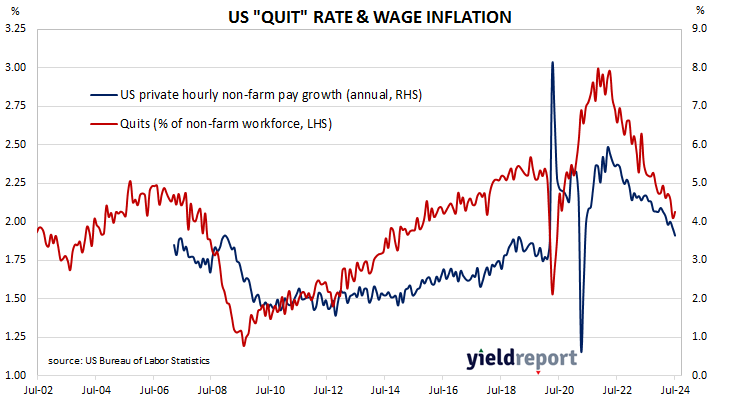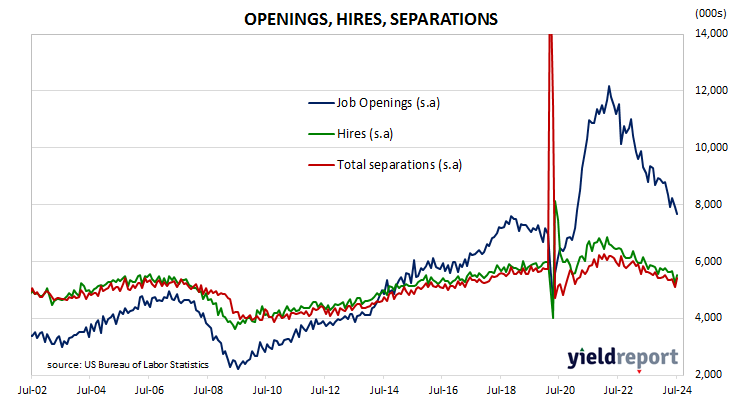Summary: US quit rate ticks up to 2.1% in July after revisions; US Treasury yields fall; expectations of Fed rate cuts firm; more quits, more separations, fewer openings; ANZ: job vacancies lowest since January 2021.
The number of US employees who quit their jobs as a percentage of total employment increased slowly but steadily after the GFC. It peaked in March 2019 and then tracked sideways until virus containment measures were introduced in March 2020. The quit rate then plummeted as alternative employment opportunities rapidly dried up. Following the easing of US pandemic restrictions, it proceeded to recover back to its pre-pandemic rate in the third quarter of 2020 and trended higher through 2021 before easing through 2022, 2023 and the first half of 2024.
Figures released as part of the latest Job Openings and Labor Turnover Survey (JOLTS) report show the quit rate ticked up in July after revisions. 2.1% of the non-farm workforce left their jobs voluntarily, up from June’s downwardly-revised rate of 2.0%. Quits in the month increased by 63,000 while an additional 114,000 people were employed in non-farm sectors.
US Treasury yields fell noticeably across a now-flattened curve on the day. By the close of business, the 2-year Treasury bond yield had shed 11bps to 3.76% while 10-year and 30-year yields both finished 7bps lower at 3.76% and 4.06% respectively.
In terms of US Fed policy, expectations of a lower federal funds rate in the next 12 months firmed, with nearly nine 25bp cuts now factored in. At the close of business, contracts implied the effective federal funds rate would average 5.18% in September, 4.68% in November and 4.44% in December. August 2025 contracts implied 3.13%, 220bps less than the current rate.
The rise in total quits was led by 46,000 more resignations in the “Health care and social assistance” sector while the “Professional and business services” sector experienced the largest decrease, 57,000. Overall, the total number of quits for the month increased from June’s revised figure of 3.214 million to 3.277 million.
Total vacancies at the end of July decreased by 237,000, or 3.0%, from June’s revised figure of 7.910 million to 7.673 million. The fall was driven by 187,000 fewer open positions in the “Health care and social assistance” sector while the “Professional and business services” sector experienced 178,000 more offerings, the single largest increase. Overall, 10 out of 18 sectors experienced fewer job openings than in the previous month.
“The number of job vacancies is the lowest since January 2021,” said ANZ senior economist Catherine Birch. “The ratio of the number of job openings to available workers fell to 1.07:1 in July. That compares with the 0.92:1 pre-pandemic 5-year average. If the ratio drops below 1:1, that indicates upside risks to the unemployment rate.”
Total separations increased by 336,000, or 6.6%, from June’s revised figure of 5.084 million to 5.420 million. The rise was led by the “Health care and social assistance” sector where there were 108,000 more separations while the “Retail trade” sector experienced 44,000 fewer separations. Separations increased in 11 of the 18 sectors.
The “quit” rate time series produced by the JOLTS report is a leading indicator of US hourly pay. As wages account for around 55% of a product’s or service’s price in the US, wage inflation and overall inflation rates tend to be closely related. Former Federal Reserve chief and current Treasury Secretary Janet Yellen was known to pay close attention to it.



